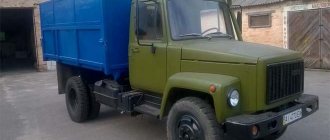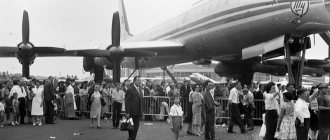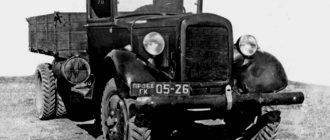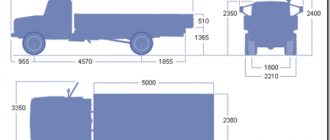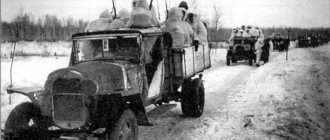General information
The GAZ-2705 car was created at the Gorky Automobile Plant (Nizhny Novgorod) in 1995. A small model capable of transporting up to 1 ton of cargo turned out to be very successful due to its unpretentiousness in operation and maintenance.
Van GAZ-2705
In the initial years of production, the GAZ-2705 became the sales leader in the class of light commercial vehicles. This was also facilitated by the fact that a driver’s license with category “B” is sufficient to drive a vehicle.
To this day, the car has an all-metal body, although in general it has undergone a number of serious design changes. In total, about 60 different options and modifications have been developed.
The only competitor to the Gazelle in the 90s was Bychok.
The weight of which was 7 tons, which did not meet market requirements.
GAZ-2705 Gazelle-Business Photo Video Characteristics Weight
GAZ-2705, a utility vehicle of the Gazelle family with an all-metal body. The vehicle is distinguished by high driving performance, good maneuverability, a large cargo compartment volume and a comfortable cabin. The frame design gives the car additional strength and reliability. The first car rolled off the GAZ assembly line in December 1995.
Analogs
UAZ "Farmer"
The domestic analogue of the GAZ-2705 is the UAZ Farmer (UAZ-39094).
UAZ "Farmer" (UAZ-39094)
UAZ "Farmer" (UAZ-39094)
UAZ "Farmer" (UAZ-39094)
Foreign models, of course, are more expensive and, with similar functionality, have higher quality interior materials.
Hyundai Porter
Hyundai Porter
Citroen Jumper
Citroen Jumper
Peugeot Boxer
Peugeot Boxer
Fiat Ducato
Fiat Ducato
GAZ-2705 Gazelle-Business - video review
A van and a cargo-passenger “Combi” were produced with 4x2 and 4x4 wheel arrangements. The body of the base model has hinged rear doors or a wide sliding side door, the width of the latter allows you to load a standard Euro pallet into the car. There is a partition behind the driver's seat that separates the interior from the cargo compartment. The loading height is reduced to 750 mm, the load capacity reaches 1400 kg, and the cargo compartment volume is 9 m³. GAZ-2705 “Combi” is a seven-seater car that can carry up to 950 kilograms of cargo. There are two rows of seats in the cabin: the first row is in the cabin, the second is next to the side door. Behind the rear seats there is a spacious cargo compartment with a volume of 6 m³. For passenger convenience, the Combi comes standard with a sunroof.
The car can be equipped with three types of engines. The GAZ-2705-044 is equipped with a ZMZ 4026.10 gasoline engine running on AI-92 gasoline. GAZ-2705-034 is equipped with a ZMZ 4063.10 gasoline engine with a microprocessor ignition system, which also consumes AI-92 gasoline. GAZ 2705-112 is equipped with a GAZ-560 diesel engine, produced under an Austrian license (Steyr). The base model is equipped with a four-cylinder petrol engine with a displacement of 2446 cm³ and a power of 90 hp. s., as well as a five-speed gearbox. There are many modifications of the GAZ-2705, in particular the GAZ-27053 medical vehicle and the GAZ-27056 all-wheel drive ambulance.
Device
The all-metal body of the GAZ cargo-passenger van is the supporting structure. In addition, it is equipped with a washer, heater and windshield wiper.
9 years
constitutes the established life of the body under normal operating conditions
The internal space of the all-metal cargo GAZelle is divided by a special partition.
The 5-speed manual transmission is an improved version of the manual transmission from GAZ-24. Smooth gear shifting is made possible thanks to the installed hydraulic drive. The gear ratio is 5.125 and each stage has a synchronizer.
See also the article Gas 33081 “Jager” and its technical characteristics
Manual transmission GAZ-2705
GAZ-2705 has 3 brake systems:
- working with separate axle braking;
- spare brake system;
- a parking brake system that acts on the brake mechanism of the rear wheels.
There is no significant heating of the system during heavy braking.
Because combined brakes are used, the service life of which is longer than that of competitors.
Later models have power steering and an independent heater, the consumption of which is 1 l / 8 hours.
Technical characteristics of GAZ-2705
— Body type: van — Number of seats: 2+1 — Drive type: rear
Engine GAZ-2705
UMZ-42164. Gasoline, 4-stroke, injection - Engine volume: 2.89 l - Engine power: 106.8 hp. at 4000 rpm min - Maximum torque, net, N*m (kgcm): 220.5 (22.5) at 2500
Cummins ISF2.8s4129P. Diesel, turbocharged - Engine displacement: 2.8 liters. — Rated power, net kW (hp): 88.3 (120) at 3600 rpm — Maximum torque, net, N*m (kgcm): 270 (27.5) at 1400-3000 rpm min
Maximum speed of GAZ-2705
— 130 km/h
Gearbox: manual 5st.
Fuel consumption GAZ-2705
UMZ-42164 — Fuel consumption when driving at a speed of 60 km/h, l/100 km: 10.5 — Fuel consumption when driving at a speed of 80 km/h, l/100 km: 13
Cummins ISF2.8s4129P — Fuel consumption when driving at a speed of 60 km/h, l/100 km: 8.5 — Fuel consumption when driving at a speed of 80 km/h, l/100 km: 10.3
Ecological class GAZ-2705
— Euro-4
Overall dimensions of GAZ-2705
— Length, mm: 5475 — Width, mm: 2073 — Height, mm: 2200 — Ground clearance, mm: 170 — Wheelbase, mm: 2900 — Front wheel track, mm: 1720 — Rear wheel track, mm: 1560
Weight GAZ-2705
— Curb weight, kg: 2140 — Gross weight, kg: 3500
Tank volume GAZ-2705
— 64 liters
Load capacity of GAZ-2705
- van up to 1350 kg with two passenger seats - Combi - 6 passenger seats and 1 t of cargo
Tire size GAZ-2705
— 175/80 R16
A little about the history of the Sobol family
Serial production of cars of the GAZ-2752 Sobol family started in Nizhny Novgorod in 1998. By that time, the GAZelle had been in mass production for four years already, and it became obvious that the demand for cars of this class, which had not yet been completely mastered by the domestic automobile industry, turned out to be much higher than the wildest assumptions. Therefore, the range of modifications within the family grew; and, in accordance with market requirements, a related family was created - “Sable”.
The UAZ-3727 prototype is one of the “ancestors” of the GAZelle and Sobol.
The design team, under the leadership of Vladimir Chetverikov, relied on both domestic and foreign experience when creating the GAZelle family. In particular, for the promising development of NAMI (Central Research Automobile and Automotive Engine Institute) and UAZ engineers - the all-metal van "UAZ-3727", which did not go into production. Many also point out the more than obvious similarities between the GAZelle and Sobol and the third generation Ford Transit.
“Externally, there really was a common motive,” Vladimir Chetverikov could not help but agree with this analogy, “but this common motive - a half-hood layout - is typical for most cars of this class.”
The frame for all modifications of the Sobol was taken from the GAZelle, with the side members shortened (wall thickness 3.9 mm) and the wheelbase reduced from 2900 to 2760 mm. The all-metal Sobol van GAZ-2752 is a GAZ van shortened by 660 mm.
"Pre-styling" "Sable" of the first generation.
Since the GAZ-2752 Sobol entered the assembly line four years later than the GAZelle, it was not affected by the time of early modernization of the new model - with the replacement of multi-leaf semi-elliptical springs with few-leaf parabolic ones; Spicer drive axle on banjo, cabin reinforcement; fighting the boiling of antifreeze in the radiator already with the arrival of April warmth... We can say that “Sable” was cured of “childhood diseases” even before its appearance.
In 2003, Sobol, like GAZelle, underwent restyling, which significantly updated its appearance and interior. In accordance with the current “automotive fashion”, the tail design was updated, the rectangular headlights were replaced with modern drop-shaped block headlights. The instrument panel in the cockpit has also been updated and radically changed.
In February 2010, the Gorky Automobile Plant began producing a restyled family of this car, under the Sobol-Business brand. The package of modernized components and assemblies of this version is similar to the GAZelle-Business family. “Sobol” is presented in the price list of the Gorky Automobile Plant in a variety of options: an all-metal van or minibus, a flatbed truck or a universal chassis for installing all kinds of superstructures and special equipment.
Optimal car tire pressure
The main task of car tires is to provide effective traction between the car and the road. With normal air pressure in the tire, the load in the contact patch of the wheel with the road is distributed evenly, due to which tire wear occurs evenly, the car handles well and fuel consumption is within normal limits.
There are three possible scenarios in which the tire pressure will not be optimal:
- Increased pressure (tires overinflated);
- Low pressure (tires underinflated);
- Different pressure in all wheels.
Check the tire pressure with a special tire pressure gauge. This should only be done on cold tires, that is, before leaving the parking lot or garage.
If deviations from the normal pressure are detected in any of the tires (see the table below for what pressure should be in the tires of your passenger car), such a wheel must either be inflated or excess air released from it - that is, the pressure must be adjusted to norm. In one of our articles, we already talked about which car compressor is best for inflating tires.
It is worth noting that the tire pressure in winter should be exactly the same as in summer. But due to the sharp temperature change, in winter, monitoring the air pressure in the wheels needs to be approached more responsibly.
It is better to inflate your tires outside. Also, do not forget to check the tire pressure when there are significant changes in ambient temperature, and if necessary, adjust it:
- if it gets cold outside, the pressure in the tires will decrease,
- and when it gets warmer, it will rise.
It should also be remembered that while the car is moving, the tires heat up, the air in them expands, and the pressure increases, and the handling and braking properties change.
Increased tire pressure
With increased tire pressure, the load at the point of contact of the wheel with the road acts to a greater extent on the central part of the tire tread, thereby causing uneven wear of the tire.
On overinflated wheels, the car brakes worse! This happens because if the tires are overinflated, the contact patch with the road decreases, which means the friction force that keeps the car from sliding decreases. At the same time, the braking distance increases noticeably.
In just twenty minutes of driving, taking turns as aggressively as possible, the pressure in the car’s tires can increase by 0.5 atmospheres. And on long trips at high speed, the pressure in the tires can increase to 4-5 atmospheres. And modern tires are designed for this.
But if the tire has a hernia or cut, it can heat up and explode while driving. But on the road it’s a disaster.
Low tire pressure
Wheels lowered to just half an atmosphere change the behavior of the car and become unusable much earlier than expected. When the pressure is low, the load on the tire surface is distributed unevenly. In this case, the sidewalls of the tire where the tire contacts the road are subject to increased wear.
The sidewalls of flat tires are softer and bend when you turn the steering wheel. The trajectory of the wheel and tire do not match, so the car responds to the steering wheel late.
Moreover, if the tire pressure is reduced, the wheel may even come off during a sharp turn.
Therefore, it is very important to regularly check tire pressure and maintain it within normal limits.
This is especially true in winter, since in cold weather the tire pressure can easily drop by 0.3 (or even 0.5) atmospheres.
It is also worth keeping in mind that low air pressure in the wheels leads to increased fuel consumption. Just in case, we remind you that our website has an excellent selection of tips on how to reduce fuel consumption in a car - be sure to read it, you will probably find something new for yourself.
Different pressure in car tires
The most common situation among drivers is when the pressure in all wheels is different. There can be many reasons, for example:
- Faulty spool valves;
- Uneven tire wear;
- Or perhaps you caught a nail with the wheel.
During emergency braking, in this case, the coefficient of road adhesion between inflated and lowered wheels will be different, which with a high degree of probability will lead to the car skidding or turning across the road.
If the car starts to pull even a little to the side, there is a reason to check how the tires are inflated. And remember that tires don’t last forever. Even very good tires need care.

